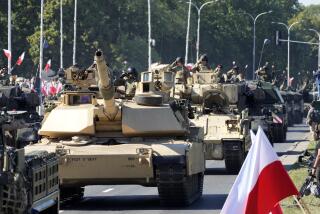U.S., China Spar on Defense
- Share via
BEIJING — High-level talks this week may have begun to thaw U.S.-Chinese military relations, but the two sides still strongly disagree over how much Beijing spends annually on its armed forces.
After meeting with Defense Secretary Donald H. Rumsfeld on Wednesday, Chinese Defense Minister Cao Gangchuan rejected a Pentagon claim that China vastly underreports its military expenditures, saying the publicly released figure of about $30 billion is the “true budget” for his nation’s defense spending.
The government’s domestic priorities and the need to address poverty prevent Beijing from spending more on defense, Cao said. “It is simply impossible for us to massively increase the investment into defense capabilities,” he told reporters.
In remarks to Beijing’s Academy of Military Sciences this morning, Rumsfeld reiterated the U.S. stance that China spends billions more than it admits to, and he said there were growing fears throughout Asia about the nation’s military intentions.
“To the extent that defense expenditures are judged to be considerably higher than what is published, neighbors understandably wonder what the reason might be for the disparity between what they believe to be reality and public statements,” he said.
A Pentagon report released in July estimated that China was spending up to $90 billion annually on its military. In a May study, the Rand Corp., a Santa Monica think tank, put the figure at between $69 billion and $78 billion. The U.S. defense budget is more than $400 billion.
One reason for the discrepancy in the Chinese budget figures, the Pentagon report noted, is that Beijing does not include in its official budget foreign arms purchases (including up to $3 billion worth annually from Russia), expenditures on nuclear weapons, and some research and development spending.
Still, U.S. officials said they were concerned less with the amount that China was spending on its armed forces and more about the lack of openness in its military accounting.
In their meeting Wednesday, Rumsfeld and Cao pledged that improving ties between the two militaries would become a top priority, and U.S. officials said the two sides discussed arranging more opportunities for American and Chinese military officers to study at each other’s training academies.
Later, Rumsfeld met with President Hu Jintao and discussed strengthening ties with the People’s Liberation Army.
Also Wednesday, Rumsfeld toured the 2nd Artillery Corps headquarters, Beijing’s nuclear- and conventional-missile command center. Pentagon officials had asked to visit the site, and a senior U.S. defense official on the trip said Chinese acceptance was “a signal that they are willing to engage, albeit gingerly.”
The facility’s commander, Gen. Jing Zhiyuan, told Rumsfeld that China has a “no first use” policy for its nuclear arsenal. Pentagon officials believe that the statement was China’s attempt to assuage U.S. concerns about Beijing’s nuclear policy after Maj. Gen. Zhu Chenghu, a dean at China’s National Defense University, said in July that if the United States attacked his country while defending Taiwan, Beijing would respond with nuclear weapons.
Rumsfeld was the first foreign official to tour the 2nd Artillery Corps headquarters. Afterward, Chinese officials presented him with a large guest book and asked the Defense secretary to record his visit.
Rumsfeld’s name became the first entry.
More to Read
Sign up for Essential California
The most important California stories and recommendations in your inbox every morning.
You may occasionally receive promotional content from the Los Angeles Times.








